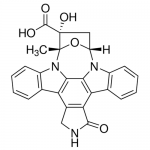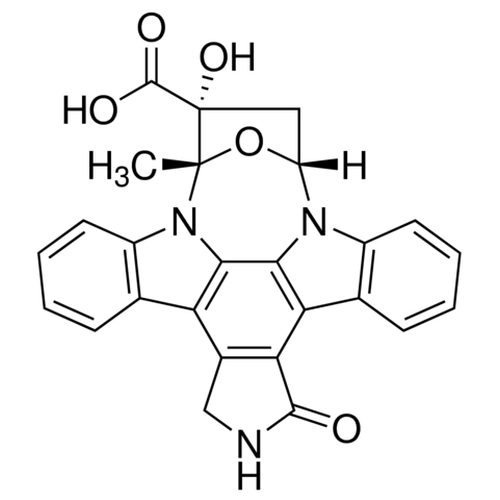| Product Name | K252B |
| Description |
Kinase inhibitor |
| Purity | >98% (HPLC) |
| CAS No. | 99570-78-2 |
| Molecular Formula | C26H19N3O5 |
| Molecular Weight | 453.5 |
| Field of Use | Not for use in humans. Not for use in diagnostics or therapeutics. For in vitro research use only. |
Properties
| Storage Temperature | -20ºC |
| Shipping Temperature | Shipped Ambient |
| Product Type | Inhibitor |
| Solubility | Soluble in DMSO (1 mg/ml) or dimethyl formamide (1 mg/ml) |
| Source | Synthetic |
| Appearance | White solid |
| SMILES | C[C@]12[C@@](C[C@H](O1)N3C4=CC=CC=C4C5=C6C(=C7C8=CC=CC=C8N2C7=C53)CNC6=O)(C(=O)O)O |
| InChI | InChI=1S/C26H19N3O5/c1-25-26(33,24(31)32)10-17(34-25)28-15-8-4-2-6-12(15)19-20-14(11-27-23(20)30)18-13-7-3-5-9-16(13)29(25)22(18)21(19)28/h2-9,17,33H,10-11H2,1H3,(H,27,30)(H,31,32)/t17-,25+,26+/m1/s1 |
| InChIKey | AMSOPBXQXSAAAC-PLZPTFKGSA-N |
| Safety Phrases |
Classification: Flammable liquids (Category 4), H227 Safety Phrases: S22 - Do not breathe dust. S24/25 - Avoid contact with skin and eyes. S36/37/39 - Wear suitable protective clothing, gloves and eye/face protection. Hazard statements: H227 Combustible liquid Precautionary statements: P210 Keep away from heat/sparks/open flames/hot surfaces. - No smoking. P280 Wear protective gloves/ protective clothing/ eye protection/ face protection. P370 + P378 In case of fire: Use dry sand, dry chemical or alcohol - resistant foam for extinction. P403 + P235 Store in a well - ventilated place. Keep cool. P501 Dispose of contents/ container to an approved waste disposal plant |
| Cite This Product | K252B (StressMarq Biosciences Inc., Victoria BC CANADA, Catalog # SIH-456) |
Biological Description
| Alternative Names | (9S,10R,12R)-2,3,9,10,11,12-hexahydro-10-hydroxy-9-methyl-1-oxo-9,12-epoxy-1H-diindolo[1,2,3-fg:3',2',1'-kl]pyrrolo[3,4-i][1,6]benzodiazocine-10-carboxylic acid |
| Research Areas | Apoptosis, Cancer, Cancer Growth Inhibitors, Cell Signaling, Tyrosine Kinase Inhibitors |
| PubChem ID | 9981344 |
| Scientific Background | K252B is a non-selective, protein kinase inhibitor. It inhibits CaMKII, MYLK, PKA, PKC, and cGKI. It acts by binding to the ATP binding domain of the kinase. K252B is cell permeable. |
| References |
1. Nakanishi S., Matsuda Y., Iwahashi K., & Kase H. (1986) J. Antibiotics 39(8): 1066–1071. 2. Teshima R., et al. (1997) J. Immun. 159(2): 964–969. 3. Knüsel B., et al. (1992) J. Neurochem. 59(2): 715–722. |



Reviews
There are no reviews yet.